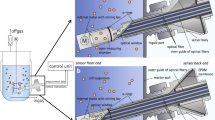Abstract
We describe an algorithm for the continuous monitoring of the biomass and ethanol concentrations as well as the growth rate in the Mezcal fermentation process. The algorithm performs its task having available only the online measurements of the redox potential. The procedure combines an artificial neural network (ANN) that relates the redox potential to the ethanol and biomass concentrations with a nonlinear observer-based algorithm that uses the ANN biomass estimations to infer the growth rate of this fermentation process. The results show that the redox potential is a valuable indicator of the metabolic activity of the microorganisms during Mezcal fermentation. In addition, the estimated growth rate can be considered as a direct evidence of the presence of mixed culture growth in the process. Usually, mixtures of microorganisms could be intuitively clear in this kind of processes; however, the total biomass data do not provide definite evidence by themselves. In this paper, the detailed design of the software sensor as well as its experimental application is presented at the laboratory level.





Similar content being viewed by others
References
De León-Rodríguez A, González-Hernández L, Barba de la Rosa AP, Escalante-Minakata P, López MG (2006) Characterization of volatile compounds of Mezcal, an ethnic alcoholic beverage obtained from Agave salmiana. J Agric Food Chem 54:1337–1341
De León-Rodríguez A, Escalante-Minakata P, Barba de la Rosa AP, Blaschek HP (2008) Optimization of fermentation conditions for the production of the Mezcal from Agave salmiana using response surface methodology. Chem Eng Proc 47:76–82
Escalante-Minakata P, Blaschek HP, Barba de la Rosa AP, Santos-Martínez ML, De León-Rodríguez A (2008) Identification of yeast and bacteria involved in the mezcal fermentation process. Lett Appl Microbiol (in press)
Chen LZ, Nguang SK, Li XM, Chen XD (2004) Soft sensors for online biomass measurements. Bioprocess Biosyst Eng 26:191–195
Locher G, Sonnleitner B, Fiechter A (1992) Online measurement in biotechnology: techniques. J Biotechnol 25:23–53
Bastin G, Dochain D (1986) Online estimation of microbial specific growth rates. Automatica 22(6):705–709
Farza M, Busawon K, Hammouri H (1998) Simple nonlinear observers for online estimation of kinetic rates in bioreactors. Automatica 34(3):301–318
Kwong SCW, Randers L, Govin R (1992) Online assessment of metabolic activities based on culture redox potential and dissolved oxygen profiles during aerobic fermentation. Biotechnol Prog 8:576–579
Beroviĉ M (1999) Scale-up of citric acid fermentation by redox potential control. Biotechnol and Bioeng 64(5):552–557
van Dijk C, Ebbenhorst-Selles T, Ruisch H, Stolle-Smits T, Schijvens E, van Deelen W, Boeriu C (2000) Product and redox potential analysis of Sauerkraut fermentation. J Agric Food Chem 48:132–139
Cheraiti N, Guezenec S, Salmon JM (2005) Redox interactions between Saccharomyces cerevisiae and Saccharomyces uvarum in mixed culture under enological conditions. Appl Environ Microbiol 71(1):255–260
Kukec A, Berovič M, ·Celan S, Wondra M (2002) The role of online redox potential measurement in Sauvignon blanc fermentation. Food Technol Biotechnol 40(1):49–55
Novák L, Larrea L, Wanner J (1994) Estimation of maximum specific growth rate of heterotrophic and autotrophic biomass: a combined technique of mathematical modelling and batch cultivations. Water Sci Technol 30:171–180
Wanner J (1994) Activated sludge bulking and foaming control. Technomic Publishing, Lancaster
Gujer W, Henze M, Mino T, Matsuo T, Wentzel MC, Marais GR (1995) The activated sludge model no. 2: biological phosphorus removal. Water Sci Technol 31:1–11
Reeves GT, Narang A, Pilyugin SS (2004) Growth of mixed cultures on mixtures of substitutable substrates: the operating diagram for a structured model. J Theor Biol 226:143–157
Ibarra-Junquera V, Escalante-Minakata P, Murguía JS, Rosu HC (2006) Inferring mixed-culture growth from total biomass data in a wavelet approach. Physica A 370(2):777–792
Benn SM, Peppard TL (1996) Characterization of tequila flavor by instrumental and sensory analysis. J Agric Food Chem 44:557–556
López MG (1999) Tequila aroma. In: Shahidi F, Ho CT (eds) Flavor chemistry of ethnic foods. Kluwer Academic, Plenum Publishers, New York
López MG, Dufour JP (2001) Tequilas: charm analysis of blanco, reposado, and añejo tequilas. In: Leland JV, Schieberle P, Buettner A, Acree TE (eds) Chromatography–olfactometry. The state of the art. ACS symposium series 782. American Chemical Society, Washington DC
Vallejo-Córdoba B, González-Córdoba AF, Estrada-Montoya MC (2004) Tequila volatile characterization and ethyl ester determination by solid phase microextraction gas chromatography/mass spectrometry analysis. J Agric Food Chem 52:5567–5571
Nielsen J, Villadsen J, Liden G (2003) Bioreaction engineering principles. Kluwer Academic Plenum Publishers, New York
Lapedes AS, Farber RM (1987) Nonlinear signal processing using neural networks: prediction and system modeling. Los Alamos Report LA-UR-87, 2662
Rumelhart D, McClelland J (1986) Parallel distributed processing: explorations in microstructure of cognition, vol. 1: foundations. MIT Press, Cambridge Massachusetts
Acknowledgments
P. Escalante-Minakata thanks CONACyT for a postdoctoral fellowship allowing her to work at the University of Colima. V. Ibarra-Junquera thanks PROMEP for the financial support. H.C. Rosu is partially supported through CONACyT Project 46980.
Author information
Authors and Affiliations
Corresponding author
Rights and permissions
About this article
Cite this article
Escalante-Minakata, P., Ibarra-Junquera, V., Rosu, H.C. et al. Online monitoring of Mezcal fermentation based on redox potential measurements. Bioprocess Biosyst Eng 32, 47–52 (2009). https://doi.org/10.1007/s00449-008-0219-3
Received:
Accepted:
Published:
Issue Date:
DOI: https://doi.org/10.1007/s00449-008-0219-3




